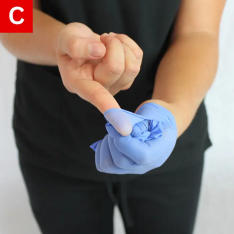- Overview
- Introduction
- Protect Yourself from Bloodborne Pathogens
- Act When you Come into Contact with Blood
- Clean up the Mess
- Report Exposure to Blood or Blood-containing Fluids Immediately
- What’s Next?
Act When you Come into Contact with Blood
Coming into contact with blood includes blood on your PPE and/or yourself. Even with following all the previous proactive measures to prevent exposure, you may experience times where your skin or other bodily surfaces do come into contact with them. This section will teach you how to respond to such an event.
IMMEDIATE ACTION IS ESSENTIAL FOR DIRECT EXPOSURE TO MUCOUS MEMBRANES
- Take gloves off.
- Wash hands and any exposed skin.
- Rinse mucous membranes with copious amounts of water.
- Report the Incident.
- Follow through with employer protocols.



HOW DO YOU REMOVE GLOVES PROPERLY?
Removing gloves is not as simple as it sounds. Follow these steps to remove gloves without touching the dirty side to your skin.
- Grip the outside of one glove near the wrist (Figure 5a).
- Pull upward slightly until the glove comes off smoothly (inside out).
- Cup the old glove in the hand with the remaining glove still on. Using your clean hand, slide your fingers beneath the surface of the glove near the wrist (Figure 5b).
- Peel the glove towards your fingers, encasing the first glove in it (Figure 5c).
- Dispose of the contaminated gloves properly, such as in a biohazard bag or in a plastic bag to seal the hazard until placement in an appropriate biohazard container.
- Wash your hands.
WHAT ABOUT THE DISPOSAL OF SHARPS?
Sharps are another source of possible exposure to bloodborne pathogens. Sharps include needles, lancets, or any object that is used to pierce the skin.
Sharps should always be disposed of in a puncture-resistant sharps container (Figure 6). These will have the biohazard symbol and indicate “sharps” somewhere on the container.
WHO CAN COME INTO CONTACT WITH SHARPS?
Disposal workers, sanitation and janitorial employees and everyone who is present where that container goes can come into contact with sharps after they are used. In addition, staff members should discard sharps in an appropriate container immediately after use, reducing the chances of sticking themselves or another person in the process.
RECAPPING NEEDLES IS NOT ACCEPTABLE!
Never try to recap sharps. Most have a recapping proof design, and if you do recap sharps, your facility could be fined for doing so.
 Figure 6
Figure 6
